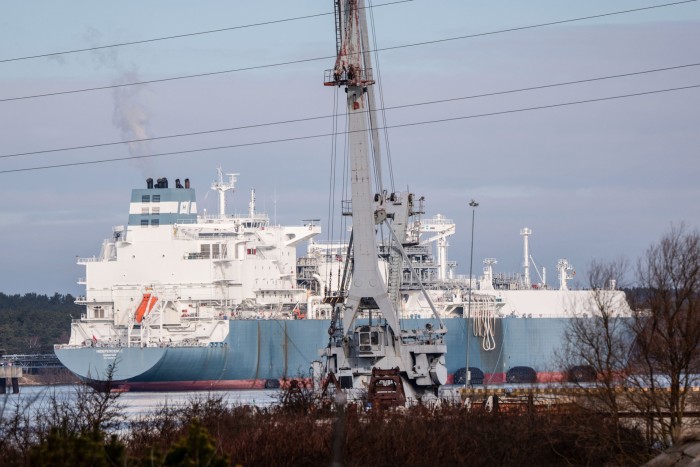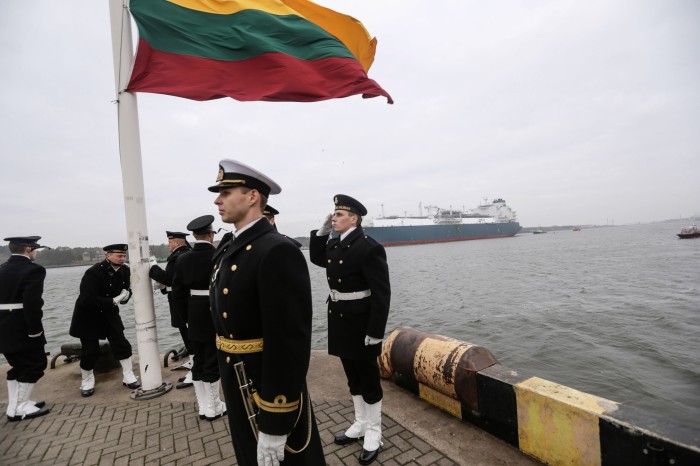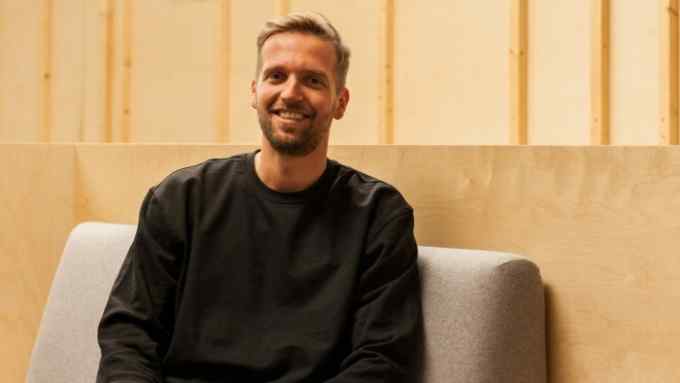Lithuania proves prescient on risk of Russian energy

Simply sign up to the EU energy myFT Digest -- delivered directly to your inbox.
If anybody doubted the subtle messaging of Lithuania’s foreign policy, it becomes clear from the name of the floating liquefied natural gas (LNG) terminal that the Baltic country built to wean itself off Russian gas: “Independence”.
“The name is symbolic: it’s against Russia, it’s against Russian gas,” explains Mindaugas Navikas, chief commercial officer of KN, the operator of the Independence terminal.
Lithuania was one of the first countries to feel Russia’s weaponisation of energy. After it declared its independence from the Soviet Union in 1990, Moscow pressured it by cutting oil deliveries and reducing gas supplies. “It was a very good wake-up call. . . a reminder of how vulnerable we were at that time,” says Albinas Zananavičius, Lithuania’s deputy energy minister.
More followed. An oil pipeline from Russia to Lithuania was closed in 2006 for repairs, and has still not re-opened. And, in the 2000s and 2010s, Lithuania was paying one of the highest prices for gas in Europe from its sole supplier, the Russian group Gazprom.
“We were an island isolated from all friends,” says Linas Linkevičius, former foreign minister. “We paid the highest prices in Europe.” Navikas says simply: “We know how Russia is behaving and it’s not about business.”
By 2014, the Independence terminal was in place at the Baltic Sea port of Klaipėda. The original plan was to provide competition to Gazprom — and, indeed, the Russian company lowered its prices to Lithuania as the terminal came online.
But the terminal was controversial as LNG prices were above the pipeline costs. Every Lithuanian had to pay a fee for the terminal on their gas bills.
“At the time, it looked a very crazy idea” says Zananavičius. “It didn’t make very obvious economic sense. But it was like an insurance policy.” He adds that the terminal now is on a sound economic footing.

Since Russia’s invasion of Ukraine in February, and the resulting scramble across Europe to reduce energy purchases from Moscow, Lithuania’s decision has looked prescient. The insurance policy has been cashed in.
The LNG delivered to Klaipėda not only supplies Lithuania with gas but also Latvia, Estonia, and even Finland and Poland. The terminal’s capacity is 30-40 per cent higher than Lithuania’s consumption but only about half of that of all the Baltics and Finland, according to Navikas.
So he welcomes plans by Finland to have its own floating terminal, to further ease the region’s energy worries. KN, with eight years of experience from Independence, is also now operating an LNG terminal in Brazil and selling services to others being built in Germany, Croatia and South America.
Navikas argues that it is important for governments to take energy decisions — which can take a decade to come to fruition — with geopolitics and geostrategy in mind, more than a sole focus on financials.
“Most likely it means it should be politically driven decisions, not economic decisions,” he says. “If it would be only business decisions, I don’t know how it would end up.”
With oil independence achieved in 1999 thanks to its own terminal, the last remaining piece of the puzzle for Lithuania is electricity. The Baltic countries are still connected to an electricity system with Russia and Belarus, known as Brell.
Although Lithuania no longer imports electricity from Russia, it is a big power importer from other countries, as its main local source of generation, the Ignalina nuclear plant, was closed in 2009 due to safety concerns. A plan to build a replacement fell through due to the results of a referendum, leaving Lithuania as the country importing the most electricity in the EU. “The blame game is still continuing,” says Zananavičius of the referendum.
Lithuania has built electricity interconnectors to Sweden and Poland but prices have still been very high this year. Zananavičius says: “The war in Ukraine shows that, despite good interconnections, it’s necessary to generate a certain amount of electricity — at least 70 per cent — locally, in order to ensure your security of supply and to get isolated from extreme price shocks.”
The current government has ambitious renewable energy plans — mostly offshore wind, and solar — and aims, by 2030, to reach 9GW of capacity, roughly the same as national demand. At the same time, Lithuania intends to desynchronise itself from Brell and join the system used by the rest of Europe by 2024 — though for the time being the connection helps stabilise Lithuania’s grid, providing a possible point of leverage for Russia.
“This vulnerability is a bilateral vulnerability,” says prime minister Ingrida Šimonytė, who points out that the Russian semi-exclave of Kaliningrad is equally vulnerable. She says any incident that threatened the Brell connection would be demanding but “not a calamity”, adding: “We can’t exclude that the Russians would want to do it.”
The conclusion, says Margarita Šešelgytė, director of the Institute of International Relations and Political Science at Vilnius University, is that Lithuania did well to wean itself off Russia but failed to boost its own production.
“Our dependence on Russia is close to zero,” she adds. “So we can survive without Russia. That lesson we have learned. We did everything to avoid dependency. The problem with energy is we don’t produce energy so that is why we have very high prices.”

Comments